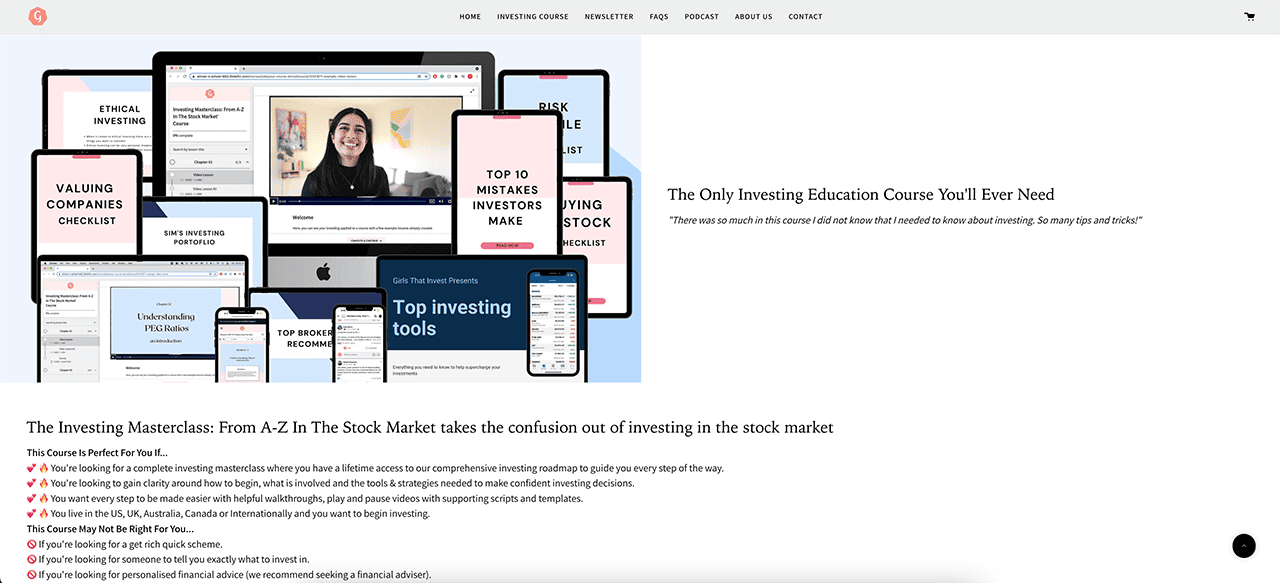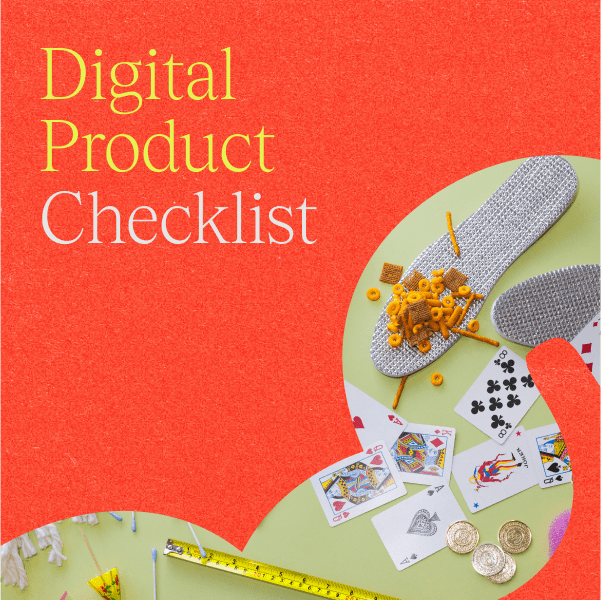Have you heard? The digital media market is set to reach $627 billion by the end of 2023. The market is booming — and savvy creators are cashing in by creating and selling digital products.
Why are these creators so savvy? Well, in addition to monetizing the digital media boom, they’ve also found a stellar source of passive income. That’s right: selling digital products allows you to earn an income while you focus on other things or just sit back and relax.
Today, digital products are one of the most popular (and profitable) forms of passive income available to content creators. Want to cash in on the multi-billion digital media pie while you sleep? Read on as we dive into the ins and outs of making a passive income selling digital products.
What are digital products?
In a nutshell, a digital product is anything you can sell online as a downloadable file. “Digital product” itself is actually an umbrella term, encompassing many different types of products, from templates (CV and résumé templates, budget trackers, etc.), ebooks (cookbooks, how-to guides, etc.), online courses, website themes, craft patterns, printable artwork, and much more.
Basically, if you can dream it up and download it, it’s a digital product. And one that’s sure to turn a profit in today’s massive digital media market.
Why are digital products ideal for making passive income?
Today, digital products have become one of the most sought-after sources of income for content creators across niches. Why? Namely because digital products are a stellar source of passive income (which is the best kind if you ask us!) This means that selling digital products allows you to earn an income while you sleep — or while focusing on the things you love to do, like creating amazing content.
So, why exactly are digital products such a powerful source of passive income? Well, there are many reasons. Let’s count them up.
Low-effort production

Digital products are downloadable files, which means that when customers purchase your digital product, they’re downloading a copy of a single master file.
This also means that a digital product only needs to be produced once. From there, customers can purchase copies ad infinitum — and you never need to invest time or effort replenishing your inventory. This means you can expect a higher return-on-investment for digital products versus their physical counterparts — all with a profit margin that increases over time. How does that sound?
Low-cost production

So, we already know that digital products are fairly low-effort to produce and sell. But it gets even better: producing and selling digital products also requires relatively little investment, especially compared to their physical counterparts. Why? That’s because digital products are made and sold primarily using digital tools, which are much more affordable than their tangible counterparts.
Selling physical merchandise requires a lot of investment: renting a brick-and-mortar store to sell from and a warehouse to store inventory. Digital products, however, are sold online rather than IRL. This means, when it comes to selling digital products, there’s no need to rent a store or warehouse — at least, not in the traditional sense.
Online, creators have the option to sell their digital products through a variety of e-commerce solutions, including an online storefront, a digital marketplace, their own website, or an online shopping cart. The options are plentiful and the best part is that they’re all relatively inexpensive compared to their real-world alternatives.
To use these e-commerce platforms, users typically pay a recurring monthly fee or, alternatively, a small percentage of each sale made on the platform. And, better yet, most of these platforms also provide file-hosting services — aka digital warehousing services — for no additional cost. When you do the math, the investment required to sell digital products comes out to significantly less than the cost of selling physical products.
No shipping logistics

When a customer purchases a digital product from your online storefront, they’re actually downloading a copy of your product to their computer or mobile device. This happens directly, instantly, and completely digitally (usually via email). Because the sale happens in cyberspace, neither you or the customer need to deal with shipping — at all.
Of course, this is great for the customer (who doesn’t have to wait for their order to arrive), but it’s even better for the seller. Selling digital products means you’ll never need to deal with the logistics (and, let’s be honest, the hassle) of shipping ever again — saving you time, effort, and likely many headaches.
Simple scalability

Want to scale your business? Digital products make it easy — and virtually infinite.
For starters, it’s much easier to scale a digital product business than one that deals with physical products. That’s because all the infrastructure exists in cyberspace, rather than IRL, where your business’s growth can be inhibited by clunky physical tools and processes, like replenishing inventory, finding new retail spaces, and tweaking shipping logistics.
Also, most e-commerce platforms today are built with scalability in mind. This means you can scale your business — like add more products to your offering or more managers to your account — in just a few clicks. It’s that easy!
What’s more is that most of these platforms have no limit on the number of products you can sell. (And if they do, the file-hosting limits are usually up in the terabytes.) So, when it comes to your digital product business, you can go ahead and dream big — and then make it happen.
Global sales

As a creator, your content reaches an international audience, so why shouldn’t your products?
Like your content, digital products exist online, which means they can be perused and purchased by anyone in the world. Without the limits of a local brick-and-mortar store or shipping restrictions, your digital products reach audiences and markets you never thought possible, earning you even more money.
3 of the most profitable digital product ideas
When it comes to the kinds of digital products you can sell online, the possibilities are almost endless. However, not all digital products are purchased equally; some definitely rise to the top of the pack when it comes to demand and profitability.
From online courses to templates of all kinds, read on as we unpack some of the best-selling digital products — and just how much you can make selling them.
1. Ebooks
Have some insight to share with your audience? Consider turning it into an ebook.
Today, ebooks are some of the most popular digital products among content creators (and especially in creator educator circles). This is because ebooks allow creators to monetize their expertise on their own terms, without having to go through gatekeepers and blockers like publishing houses.
An ebook allows creators to deliver their knowledge and expertise directly to their audience — all in one neat, well-written package. And the best part is that the ebook format caters to just about every niche and topic imaginable. Whether you’re a baker, a therapist, or a social media wizard, you can transform your expertise into an ebook. It’s all about putting that pen to paper — or, err, those keys to the keyboard.
Ebooks can take many forms, including how-to guides, business playbooks, cookbooks, and self-help manuals, like Cultivating Connection, written by therapist and content creator Simone Saunders of The Cognitive Corner. Intended as a companion to her digital workshop and therapeutic TikTok content, this ebook allows Simone to expand on topics like attachment and trauma — and earns her $24.99 a pop.

2. Templates
Have a tedious task that needs completing? There’s a template for that.
A template is a pre-formatted document designed to be edited or customized by users to create a custom document that suits their needs. In other words, a template is a digital tool that makes people’s lives a whole lot easier. And that’s exactly why there’s a massive demand for them.
Templates are one of the widest — and most profitable — digital product categories on the market. Examples of templates include budget planners, CV and résumé templates, to-do lists, workout trackers, daily journals, and even pre-designed wedding invitations. And that’s just the tip of the iceberg.
The breadth of the template category is great for two reasons. For one, it means creators from virtually any niche can transform their expertise into a template. And, secondly, it means there are tons of different markets for template creators to tap into.
For example, graphic designer and content creator Barbiana Liu combines her design expertise with her freelance experience to create helpful templates for other creatives, including a freelance contract guide, a brand style sheet template, and even a creative space template for Notion. Prices range from $15 to $25 and, to date, Barbiana has made over 200 templates sales through her Gumroad storefront.
Of course, Barbiana is a graphic designer extraordinaire. However, you don’t need advanced graphic design skills to begin creating and selling templates. Beginners can simply fire up a digital design platform like Canva or a productivity platform like Notion to bring their template ideas to life in just a few clicks.
3. Online Courses
It’s official: the internet has become the world’s hub for education. With the emergence of YouTube and TikTok, the way we learn has changed — and now, so have the markets. In light of the online education boom, creator educators are monetizing their expertise by creating and selling online courses to legions looking to learn something new.
Online courses have become one of the most popular ways for creator educators to earn an income. Why? Because online courses allow creators to turn their knowledge and know-how into a product that can be sold over and over (rather than having to spend hours in the classroom — or in front of the camera.)
There are many different kinds of online courses, ranging from the simple (a single virtual lesson) to the complex (a multi-unit masterclass). No matter how complex your online course, however, bringing it to life has never been easier thanks to popular online course builders and learning management systems like Thinkific. These digital tools allow creators to create expansive learning experiences, building out feature-rich courses that integrate presentations and videos, along with assignments, quizzes, and even community spaces for students to discuss lesson topics and learn from each other.
Speaking of feature-rich masterclasses: Girls That Invest’s online investing course, Investing Masterclass: From A-Z In The Stock Market, is a comprehensive, six-week educational roadmap that promises to take learners from beginners to confident investors. Alone, this digital product earns Girls That Invest $1 million annually.

Want to start small? Try mini-courses.
As its name suggests, a mini-course is a shorter version of an online course. Mini-courses contain less material, but still provide plenty of value to learners.
To go about creating a mini-course, you’ll want to narrow down your topic and condense the information delivered as much as possible, while keeping it relevant and valuable to your audience.
Creating a mini-course is a great way to dip your toe into the digital product game if you’re just starting out. Creating smaller, bite-sized courses can help you build up confidence to begin building and selling longer form online courses.
Want to start building and selling mini-courses today? Try out our AI-powered mini-course builder and storefront tool, The Leap, for free!
5 steps to create and sell your first digital product
Now that you know what kinds of digital products you can make, it’s time to go about creating and selling them. Wondering where to get started? We’ve got you covered. Read on for our step-to-step guide for launching your digital products.
Step 1: Do your research

In order to create and sell a digital product, you’ll first have to figure out what you’ll be selling, where you’ll be selling it, and what you’ll be selling it for. In other words, it’s time to research.
First, put yourself in your audience’s shoes. What are their pain points and what kind of solutions are they looking for? The answers to these questions will lead you to some great (and profitable) digital product ideas. Next, we suggest you search for keywords and trends within your niche via Google Trends, and the places your audience hangs out (TikTok, Instagram, etc.)
It also doesn’t hurt to check out the competition! Take a look at e-commerce platforms like Gumroad and Etsy to see what kind of digital products similar creators are selling, and how much they’re selling them for.
Step 2: Create your digital product

Next, it’s time to put your nose to the grindstone and create your digital product. The goal is to create a high-quality, high-value product, so give yourself plenty of time to put in the effort required to make sure your digital product is the best it can be.
Step 3: Choose your e-commerce platform

Now that you have your digital product, you’ve got to figure out where to sell it. And the options are aplenty.
Today, there are tons of e-commerce platforms that allow you to sell digital products. These include online storefronts (like The Leap) and digital marketplaces (like Etsy).
The options abound and each offers something a little different, so make sure you compare a few of them. In the end, your decision will depend on your niche, your audience’s needs and preferences, your business’s needs, and your budget.
Want to build a link-in-bio storefront, quickly and easily? Try The Leap free today!
Step 4: Market your product

Now that your product’s online and ready to be purchased, you need to let your audience know where to find it. As a content creator, you’ll definitely want to harness the power of social media and advertise your products through online content. On TikTok? Make a funny sketch and mention your product in it. Or Instagram? Showcase your product in a Story or dedicate a grid carousel to outlining its features.
Step 5: Build your email list

If you’re looking to grow your digital product business, you’ll need to build an email list and map out an email marketing campaign. Email marketing is a great way to directly notify your followers of important updates like new product drops.
Use your online storefront to collect customers’ and visitors’ email addresses. Once you have a list going, start sending out regular newsletters. And don’t forget to promote your newsletter on your social channels!
Top tips for making passive income from selling digital products
So, now you know the reasons why digital products are a great source of passive income, which digital products earn the most money, and, most importantly, how to start creating your own digital products. Now, it’s time to learn how to maximize your digital product income.
Be consistent in your product quality and marketing efforts

When it comes to creating content, any creator worth their salt knows consistency is key. Well, the same principle applies to selling digital products.
Before we dive into why consistency is key, let’s walk it back. First thing’s first: if you want to earn good money making digital products, you need to put in the effort to make a high-value, high-quality product. This means ensuring that your product solves an existing problem in a unique way.
This is where consistency comes in. In order to make the most out of your digital product business, you’ll need to be consistent with both the quality of your products and your marketing efforts.
Producing consistently high-quality products builds customer trust and loyalty. In other words, it creates repeat customers — and recurring income. On the other hand, consistency in your marketing efforts — advertising your products through your social media channels, newsletter, or elsewhere — increases your chances of tapping into the algorithm and reaching new customers.
Stay up-to-date with market trends and customer preferences

In the world of online content, dance crazes and viral songs come and go at hyper-speed. Keeping on top of trends and tapping into them at the right moment can almost guarantee your ticket to TikTok’s For You page. And the same can be said about digital products. Well, sort of.
Like online content, the digital product market is heavily shaped by consumer trends. So, creators looking to maximize their digital product earnings will want to stay on top of market trends as they emerge. This means keeping up with topics and trends within your niche, and checking in on the types of products your competitors are creating.
This also means surveying gaps in the current market and pain points with your target audience. Luckily, content creators have social media at their disposal to help with this task.
If you’re looking to launch a new digital product, poll your audience about their pain points, their preferences, and just what type of digital product they’d like to buy. Creating a product that will fulfill your audience’s real needs is a surefire way to turn a profit.
Embracing a growth mindset and willingness to adapt

As a content creator, you know the digital media market is constantly evolving. You also know that the way to succeed is to adapt — and to grow along with it.
When it comes to selling digital products, this type of growth-geared mindset and adaptability is crucial to success. People with a growth mindset know that there’s always room for improvement and, in turn, are always looking for ways to innovate. Having a growth mindset makes you much more adaptable to sudden changes and new information, including shifts in the market, the emergence of new trends, and customer feedback.
If you’re willing to adapt your business model, and tinker with your digital products to meet the shifting demands of the market and your customers’ ever-changing needs, you’re on your way to creating digital products that aren’t just better, but are more profitable than the ones that came before.
And that’s how to make passive income with digital products!
So, there you have it: a beginner’s guide on how to make passive income selling digital products.
Now that you know it all, it’s time to get out there and start creating (and selling) your very first digital product. Let your research, creativity, and growth mindset guide you. From there, you’ll be earning dollars as you dream in no time.
Want to start making money online? Grab our 6-step digital product launch checklist to go from an initial idea to your first sale.
FAQ
What are the most profitable digital products to sell?
There’s no single, universal answer to which digital product is the most profitable to sell. Maximizing your digital product profits depends on many different factors, including your audience, your engagement rate, your marketing efforts, and more. However, on average, the most profitable digital products to sell include ebooks, templates, online courses, and website themes.
Is it easy to make passive income from digital products?
Selling digital products is a relatively low-effort endeavor compared to selling physical products. And selling digital products does tend to yield a higher return-on-investment than selling physical products. However, selling digital products is not a “get-rich-quick” scheme. If you’re looking to make good money selling digital products, it’s important to understand that you’ll need to put in the time and effort upfront in order to create a high-value product.
That being said, if you have unique knowledge or expertise to share, as well as a decent-sized audience, you have the potential to turn them both into cash by selling digital products.
Follow The Leap on TikTok, Instagram, and YouTube for more monetization tips for creators. We also make a newsletter.




